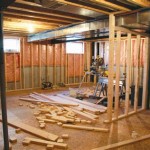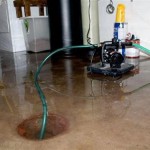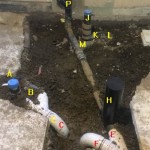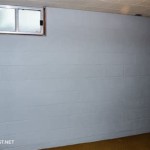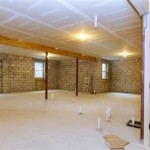How to Eliminate Mildew Odor from a Basement
A musty or mildew-like odor in a basement is a common problem for homeowners. This pervasive smell indicates the presence of mold or mildew growth, which can be detrimental to both indoor air quality and the structural integrity of the building. Addressing this issue promptly and effectively is crucial for maintaining a healthy and safe living environment. The following outlines methods for identifying and eliminating mildew odors from a basement.
The first step in addressing a mildew odor is to accurately identify the source. Mildew, a type of mold, thrives in damp, dark, and poorly ventilated environments. Basements, with their inherent tendency to accumulate moisture, often provide ideal conditions for its growth. Common sources of mildew include leaky pipes, condensation on walls and floors, inadequate drainage around the foundation, and high humidity levels. Thoroughly inspecting the basement for visible signs of mold or mildew growth is essential. This includes examining walls, floors, ceilings, around pipes, and in corners. Look for discoloration, staining, or a fuzzy texture, all of which can indicate the presence of mold or mildew.
Beyond visual inspection, paying attention to the specific characteristics of the odor can offer clues about the source and extent of the problem. A strong, localized odor often points to a specific area of concentrated growth, while a more diffuse odor may suggest a more widespread issue. Use a flashlight to illuminate dark areas and consider using a moisture meter to detect elevated moisture levels in building materials. These instruments can provide a quantifiable measure of moisture content, helping to pinpoint areas that are susceptible to mold or mildew growth.
Once the source of the mildew odor has been identified, the next step is to address the underlying moisture problem. Simply masking the odor without addressing the source will only provide a temporary solution. The mildew will continue to grow and the odor will eventually return. Common causes of basement moisture issues include:
*Poor drainage: Ensure that gutters and downspouts are properly directing water away from the foundation.
*Leaky pipes: Repair any leaks in plumbing fixtures or water lines.
*Condensation: Improve ventilation in the basement to reduce condensation on walls and floors.
*High humidity: Use a dehumidifier to lower the humidity level in the basement.
*Cracks in foundation walls: Seal any cracks in the foundation walls to prevent water from seeping in.
Addressing these underlying moisture problems is a critical step in preventing the recurrence of mildew growth and the associated odor. Failing to address the moisture source will render any cleaning efforts ineffective in the long term.
Removing Mildew from Surfaces
After addressing the moisture source, the next step is to remove the existing mildew from affected surfaces. Several cleaning solutions can be used effectively, depending on the type of surface and the severity of the mildew growth. It is important to wear appropriate protective gear, including gloves, a mask, and eye protection, when working with cleaning solutions to avoid skin irritation or respiratory problems.
For non-porous surfaces such as concrete, tile, and plastic, the following solutions can be used:
*Bleach solution: A solution of one part bleach to ten parts water is an effective disinfectant and cleaner for removing mildew. Apply the solution to the affected surface, let it sit for 10-15 minutes, and then scrub with a brush. Rinse thoroughly with clean water and allow the surface to dry completely. Bleach should never be mixed with ammonia or other cleaning products, as this can create toxic fumes.
*Vinegar: White vinegar is a natural disinfectant and deodorizer that can also be used to remove mildew. Apply undiluted vinegar to the affected surface, let it sit for an hour, and then scrub with a brush. Rinse with clean water and allow the surface to dry completely.
*Commercial mold and mildew cleaners: Several commercial mold and mildew cleaners are available for purchase. Follow the manufacturer's instructions carefully when using these products. Ensure adequate ventilation during application and rinse thoroughly after cleaning.
For porous surfaces such as drywall, wood, and carpet, the following solutions can be used:
*Baking soda: Baking soda is a mild abrasive and deodorizer that can be used to remove mildew from porous surfaces. Mix baking soda with water to form a paste, apply the paste to the affected surface, let it dry completely, and then vacuum or brush away the residue.
*Borax: Borax is a natural mineral that has antifungal and antibacterial properties. Mix borax with water to form a solution, apply the solution to the affected surface, and let it dry completely. Do not rinse. Borax can be left on the surface to prevent future mildew growth.
*Hydrogen peroxide: Hydrogen peroxide is a mild bleaching agent that can be used to remove mildew from porous surfaces. Apply 3% hydrogen peroxide to the affected surface, let it sit for 10-15 minutes, and then scrub with a brush. Rinse with clean water and allow the surface to dry completely. Test in an inconspicuous area first to ensure it doesn't discolor the material.
For severely mildew-infested porous materials like drywall or carpeting, professional remediation may be required. Replacing the affected materials is often the most effective way to eliminate the problem completely.
Deodorizing the Basement
Even after removing visible mildew, the odor may persist. This is because mildew can leave behind residual spores and volatile organic compounds (VOCs) that contribute to the musty smell. Deodorizing the basement is an important step in completely eliminating the mildew odor.
Several methods can be used to deodorize a basement:
*Ventilation: Open windows and doors to ventilate the basement and allow fresh air to circulate. This helps to remove stale air and reduce humidity levels. Use fans to improve air circulation, especially in areas that are prone to moisture buildup.
*Dehumidifiers: As mentioned previously, dehumidifiers are essential for controlling humidity levels in basements. Run a dehumidifier continuously to keep the humidity level below 50%. This will help to prevent mildew growth and reduce the odor.
*Activated carbon filters: Activated carbon filters can be used to absorb odors and VOCs from the air. Place activated carbon filters in areas where the mildew odor is strongest. Replace the filters regularly according to the manufacturer's instructions.
*Ozone generators: Ozone generators produce ozone gas, which can neutralize odors and kill mold spores. However, ozone can be harmful to humans and pets, so it is important to use ozone generators with caution. Follow the manufacturer's instructions carefully and ensure that the basement is unoccupied during ozone treatment. Ventilate the basement thoroughly after treatment before re-entering.
*Absorbent materials: Place bowls of baking soda, charcoal, or coffee grounds around the basement to absorb odors. Replace these materials regularly as they become saturated.
In addition to these methods, cleaning and deodorizing carpets, upholstery, and other soft furnishings in the basement can also help to eliminate the mildew odor. Steam cleaning is an effective way to remove mildew and odors from these items. Be sure to dry them thoroughly after cleaning to prevent future mildew growth.
Preventative Measures and Long-Term Solutions
Once the mildew odor has been eliminated, it is important to take preventative measures to prevent its return. This includes addressing the underlying moisture problems, maintaining good ventilation, and regularly inspecting the basement for signs of mold or mildew growth. Regular maintenance is crucial for long-term success.
Consider the following preventative measures:
*Improve drainage: Ensure that gutters and downspouts are properly directing water away from the foundation. Consider installing a French drain to divert groundwater away from the basement walls.
*Seal cracks and gaps: Seal any cracks in the foundation walls and around windows and doors to prevent water from seeping in. Use a waterproof sealant to ensure a durable and effective barrier.
*Install a vapor barrier: A vapor barrier can be installed on the basement walls to prevent moisture from penetrating the walls. This is especially important in basements that are below grade.
*Improve ventilation: Ensure that the basement is well-ventilated by opening windows and doors regularly. Install exhaust fans in bathrooms and laundry rooms to remove excess moisture.
*Use a dehumidifier: As mentioned previously, a dehumidifier is essential for controlling humidity levels in basements. Run a dehumidifier continuously to keep the humidity level below 50%.
*Regular inspections: Inspect the basement regularly for signs of mold or mildew growth. Check for leaks, condensation, and musty odors. Address any problems promptly to prevent them from escalating.
*Proper storage: Avoid storing items directly on the basement floor. Use shelves or pallets to elevate items and prevent them from coming into contact with moisture. Store items in airtight containers to protect them from moisture and mildew.
By implementing these preventative measures, homeowners can significantly reduce the risk of mildew growth and the associated odor in their basements. Regular maintenance and prompt attention to any moisture problems are key to maintaining a healthy and safe living environment.
Addressing a mildew odor in a basement requires a multi-faceted approach that includes identifying and eliminating the source of moisture, removing existing mildew, deodorizing the space, and implementing preventative measures. By following these steps, homeowners can effectively eliminate the mildew odor and prevent its return, creating a healthier and more comfortable living environment.

How To Get Rid Of Mold And Mildew Smell In Your Basement Aircare

How To Get That Musty Smell Out Of Your Basement

How To Get Rid Of Basement Odor And Why It Smells In The First Place

Eliminate Musty Smell In Basement Homesteading Simple Self Sufficient Off The Grid Com

Eliminating Musty Odors Smells In Basements

How To Get Rid Of Basement Odor And Why It Smells In The First Place

Basement Waterproofing And The Smells In Your Home Atlanta Cgs

Get Rid Of Musty Odor In Basement Servicemaster Restore

Musty Smell In The Basement 4 Steps To Freshness Bob Vila

Musty Smells In The House Finding Them And Getting Rid Of
Related Posts
